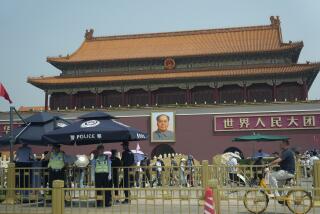Hong Kong Hand-Over a Banner Day
- Share via
BEIJING — This is a banner season for banner makers. Less than a week before Hong Kong becomes part of China again, orders for celebratory red banners--now draped across practically every building, sidewalk railing and highway overpass in sight--are still pouring in to Wang Huaiying’s shop.
“We haven’t been this busy in years,” boasted sales manager Wang, whose banner and flag factory in western Beijing has gone through more than 10,000 yards of fabric already this month.
Preparations have reached fever pitch here, as they have in Hong Kong, for next week’s hand-over festivities--arguably China’s biggest national celebration since the founding of the People’s Republic in 1949. Although Hong Kong itself will host the most lavish galas and ceremonies, the motherland is throwing its own plush parties to welcome back her long-lost child.
*
The port of Tianjin will mark the event with a relay of 1,997 flaming torches. Members of Shanghai’s elite plan to hobnob at midnight at the foot of the city’s landmark Oriental Pearl television tower.
In Beijing, two days of merrymaking will include a celebration by 100,000 people in Tiananmen Square on Monday night leading up to the midnight hand-over, and a show featuring 18,000 performers in the Workers Stadium on Tuesday.
But the fanfare isn’t for the common man.
“Ordinary people are advised not to go there,” Long Xinmin, one of the organizers, told reporters in Beijing last week, appearing not to appreciate the irony of his statement in a nation still technically under “the dictatorship of the proletariat.”
“For such a grand event, if there’s no organization, it would be hell, [with] traffic jams and the like.”
Foreign media attention to mainland activities has not been so intense as to those in Hong Kong these past few weeks; only about 500 journalists have registered to cover official events here, compared with the more than 6,000 converging on the territory itself.
But with its international prestige and image on the line, China is taking no chances that its carefully scripted festivities at home might be marred by untoward events.
Attendees of the party in Tiananmen Square, the largest gathering there since the pro-democracy protests of 1989, will be handpicked by authorities and watched by beefed-up security.
*
Beijing has declared Tuesday a national holiday to “enable the broad masses of the people to celebrate the return of Hong Kong” but also to ensure that they do it placidly at home. Government leaders have put the army and police on high alert for any unrest--from, say, unhappy minority groups or unemployed workers--that might threaten stability over the next few days.
Despite the government’s emphasis on order and moderation, public excess has already claimed at least one prominent victim: the man who designed Hong Kong’s post-colonial flag. State-run media reported Tuesday that Xiao Hong, a professor from the city of Zhengzhou whose floral flag motif won a national contest, had been hospitalized for fatigue after attending too many hand-over parties.
Xiao’s handiwork, which depicts the five stars of the Chinese national flag embedded in the petals of a white blossom on a red background, is being hoisted all around the capital these days. The city will also be festooned with 100,000 other banners, many of them manufactured by sales manager Wang’s factory and another state-owned company in Beijing.
Indeed, revenue from the hand-over will account for nearly 20% of the factory’s income this year, Wang predicted. Prices range from $25 for an average 30-foot banner to almost $500 for a massive creation more than 200 feet long and nearly 8 feet wide, to be hung from a Beijing television tower.
“Hong Kong returns--all the world rejoices!” goes one ubiquitous slogan. Other popular mottoes: “Washing away a hundred years of humiliation” and “Hong Kong will be better than ever.”
Such patriotic fervor has been diligently instilled in China’s youth, such as Wang Qingyun, 16, whose high school class in Beijing’s Xuanwu district was chosen to perform five dances at the Tiananmen Square ceremonies. Hong Kong “is a window on the outside world,” she said during a break in the stuffy auditorium where she and her classmates rehearse after school. “After returning to the motherland, it will be even more developed. I want to see it with my own eyes.”
Anthony Kuhn of The Times’ Beijing Bureau contributed to this report.
More to Read
Sign up for Essential California
The most important California stories and recommendations in your inbox every morning.
You may occasionally receive promotional content from the Los Angeles Times.











